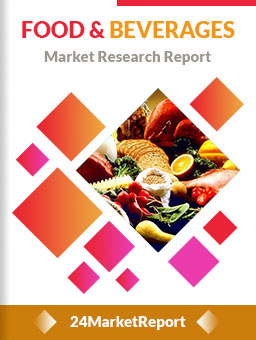
Download FREE Report Sample
Download Free sampleMARKET INSIGHTS
Global metal beer kegs market size was valued at USD 529 million in 2024. The market is projected to grow from USD 553 million in 2025 to USD 707 million by 2032, exhibiting a CAGR of 4.3% during the forecast period.
Metal beer kegs are durable stainless steel containers designed for storing and transporting beverages, primarily alcoholic drinks like beer but also accommodating non-alcoholic options. These vessels play a critical role in beverage distribution chains by maintaining product quality through superior pressure resistance and temperature control compared to alternative materials.
The market growth is driven by increasing global beer consumption, which reached 1.82 billion hectoliters in 2023 according to industry estimates, coupled with brewers' preference for sustainable packaging solutions. While Europe dominates with 40% market share due to its established brewing culture, Asia-Pacific shows the fastest growth potential as craft beer trends gain momentum. The 21-50L capacity segment leads product categories with 47% share, reflecting its optimal balance between handling convenience and volume efficiency for commercial applications.
Rising Global Beer Consumption to Fuel Metal Keg Demand
The beer industry continues to demonstrate resilient growth, with global consumption reaching over 1.87 billion hectoliters annually. This sustained demand directly benefits the metal keg market, as approximately 65% of draft beer worldwide is distributed in stainless steel kegs. The European market leads this trend, accounting for nearly 40% of global metal keg deployment, driven by Germany's thriving beer culture where per capita consumption exceeds 100 liters annually. As craft breweries expand their international footprint, the need for durable, high-quality metal kegs grows proportionally to meet export requirements and maintain product freshness across long distribution chains.
Sustainability Advantages Propel Stainless Steel Keg Adoption
To know more about market statistics, Download a FREE Sample copy
Environmental concerns are accelerating the shift from single-use packaging to reusable metal kegs, which can withstand 30+ years of service with proper maintenance. Modern breweries increasingly prioritize circular economy models, where stainless steel kegs demonstrate 92% lower carbon footprint per use cycle compared to disposable alternatives. Major brewers now include keg return programs as part of ESG commitments - Heineken's recent initiative aims for 100% reusable packaging by 2025. This transition aligns with tightening EU packaging waste regulations that now mandate 70% reuse targets for beverage containers, creating sustained demand for durable metal keg solutions.
The hospitality sector's revival post-pandemic further compounds this growth, with bar and restaurant draft systems requiring standardized kegs for beverage dispensing. Industry analysis shows foodservice venues account for 78% of keg beer sales in developed markets.
High Initial Investment and Logistic Complexities Limit Market Penetration
While metal kegs offer long-term savings, their substantial upfront costs create barriers for small breweries. A single stainless steel keg requires 3-4 times the initial capital compared to disposable alternatives, with prices ranging $100-$250 per unit depending on capacity. This financial hurdle disproportionately impacts craft brewers, who represent 30% of the U.S. beer market but often operate with constrained capital. Moreover, establishing reverse logistics for keg retrieval and cleaning demands specialized infrastructure that adds 18-22% to operational costs, discouraging adoption among regional producers with limited distribution networks.
Other Challenges
Weight-Related Transport Constraints
Standard 50L stainless steel kegs weigh approximately 15kg when empty, creating payload efficiency challenges during transportation. Freight analysis reveals aluminum keg alternatives can reduce weight by 40%, driving some brewers toward lighter materials despite their shorter lifespan. This trade-off between durability and fuel efficiency becomes particularly acute for long-distance exports, where every kilogram impacts shipping costs.
Smart Keg Technology Integration Opens New Revenue Streams
Emerging IoT solutions present transformative potential for metal keg manufacturers. Sensor-equipped smart kegs now enable real-time monitoring of contents, temperature, and location - addressing the industry's perennial challenge of lost or stolen assets worth an estimated $50 million annually. Early adopters like KegTech report 35% reductions in shrinkage through RFID tracking. Furthermore, these systems provide brewers with granular consumption data, allowing for dynamic supply chain adjustments that minimize spoilage, which currently affects 7-10% of kegged products.
The Asia-Pacific market shows particular promise, with smart keg adoption projected to grow at 28% CAGR as premium imported beers gain popularity among the region's expanding middle class. Chinese consumers now rank as the world's fourth-largest beer import market, creating substantial opportunities for keg manufacturers offering advanced tracking and quality assurance features.
Volatile Raw Material Prices Disrupt Supply Chains
Stainless steel prices have exhibited 25-30% annual fluctuations since 2020, directly impacting keg production costs. The 304-grade stainless steel used in premium kegs remains particularly susceptible to nickel price volatility, which increased 45% in 2022 alone. This unpredictability complicates long-term contract negotiations between keg manufacturers and breweries, with many opting for shorter-term agreements that limit production planning efficiency. Some European producers report 12-15 week lead time extensions due to material sourcing challenges, creating bottlenecks in keg availability during peak demand periods.
Other Challenges
Counterfeit Keg Proliferation
The growing second-hand keg market has enabled counterfeit operations that illegally modify or reproduce kegs, costing manufacturers an estimated $8 million annually in lost revenue and liability exposure. Industry groups now advocate for standardized authentication systems, but implementation varies significantly by region, creating compliance complexities for global breweries.
21~50L Segment Dominates Due to Widespread Use in Commercial Beer Distribution
The market is segmented based on capacity into:
Below 20L
21~50L
Above 50L
Stainless Steel Leads the Market Due to Superior Durability and Corrosion Resistance
The market is segmented based on material type into:
Stainless Steel
Aluminum
Copper
Other Alloys
Alcoholic Products Segment Leads Due to High Demand from Breweries and Pubs
The market is segmented based on application into:
Alcoholic Products
Non-Alcoholic Products
Commercial Sector Dominates with Extensive Usage in Bars and Restaurants
The market is segmented based on end-user into:
Commercial
Bars and Pubs
Restaurants
Hotels
Residential
Industrial
Market Leaders Leverage Stainless Steel Innovation and Brewery Partnerships
The global metal beer keg market exhibits a moderately consolidated structure, with the top five players collectively holding 52% market share in 2024. Competition centers around material durability, keg weight optimization, and compatibility with modern dispensing systems – factors critical for breweries expanding draft beer distribution networks.
THIELMANN dominates the European market (commanding over 18% regional share) through their patented UniKeg technology that reduces cleaning cycles by 30%. Their recent acquisition of two German stainless steel fabricators has strengthened vertical integration, allowing 15% faster production turnaround for craft brewer clients.
Meanwhile, Blefa GmbH (Artemis Group) differentiates through lightweight keg designs (up to 12% lighter than industry average) that cut transportation costs. Their recent partnership with AB InBev has secured long-term contracts worth $47 million annually through 2030.
Asian manufacturers like Zhejiang Ningbo Major Draft Beer Equipment are gaining traction by offering cost-competitive 20L-30L capacities preferred by the booming Asia-Pacific craft beer sector. Their automated production lines now enable 2.4 million kegs annual output at 22% lower labor costs than European counterparts.
The industry sees increasing regional specialization, with European firms focusing on premium alloy development while North American players invest in QR-code enabled smart kegs for inventory tracking. NDL Keg recently launched NFC-tagged kegs providing real-time temperature monitoring, a feature driving 27% sales growth among microbrewers.
Emerging sustainability mandates are prompting innovation as well. SCHAFER Container Systems introduced kegs with 92% recycled stainless steel content, while American Keg Company developed a carbon-neutral production process certified by the Carbon Trust in 2023.
Distribution partnerships are becoming crucial as global beer brands streamline supply chains. WorldKeg secured a milestone contract with Heineken in 2024 to supply 650,000 units annually across Latin American markets through regional manufacturing hubs.
THIELMANN (Germany)
Blefa GmbH (Artemis Group) (Germany)
Zhejiang Ningbo Major Draft Beer Equipment Co., Ltd (China)
SCHAFER Container Systems (Germany)
NDL Keg (UK)
American Keg Company (U.S.)
INOXCVA (Spain)
WorldKeg (Netherlands)
Cubic Container Systems (U.S.)
Shinhan Industrial Co., Ltd. (South Korea)
The global metal beer keg market is undergoing significant transformation as breweries and beverage distributors prioritize sustainability and operational efficiency. Stainless steel remains the dominant material, constituting over 90% of keg production, due to its durability and recyclability. However, manufacturers are increasingly adopting high-grade aluminum alloys and composite materials to reduce weight without compromising structural integrity. This shift aligns with the industry's focus on reducing carbon footprints, as lighter kegs decrease transportation costs and emissions. Recent data indicates that a 10% reduction in keg weight can lead to 5-7% savings in logistics expenses, making this innovation economically and environmentally compelling.
Capacity Optimization
The demand for mid-capacity kegs (21-50L) continues to dominate, holding 47% market share as they offer the ideal balance between serving volume and handling convenience. However, microbreweries and craft beer producers are increasingly adopting smaller sub-20L kegs, which grew at 6.2% CAGR last year, to cater to premium and experimental brews. This reflects changing consumption patterns where consumers prefer variety over bulk purchases. Larger above-50L kegs remain preferred by commercial breweries supplying high-volume venues, but their market share is slowly declining as the hospitality industry diversifies its beverage offerings.
Europe maintains its position as the largest metal beer keg market with 40% global share, driven by Germany's thriving beer culture and the UK's craft beer revolution. However, Asia-Pacific is emerging as the fastest growing region, projected to expand at 5.8% CAGR through 2032, fueled by rising disposable incomes and westernization of drinking habits in countries like China and India. The competitive landscape remains consolidated, with the top five manufacturers controlling 52% of the market. Recent mergers, such as THIELMANN's acquisition of smaller European producers, demonstrate industry consolidation aimed at achieving economies of scale and expanding geographical reach.
North America
The North American metal beer keg market benefits from a robust craft beer culture, with the U.S. accounting for over 8,000 breweries as of 2024. Major players like American Keg Company leverage this demand, focusing on stainless steel kegs between 21-50L to serve mid-sized breweries. However, competition from alternative packaging like cans and the rising cost of stainless steel (up 12% YoY in 2023) present challenges. Sustainability initiatives, such as keg leasing programs to reduce waste, are gaining traction. The region holds a 25% global market share, second only to Europe.
Europe
Europe dominates the metal beer keg market with a 40% share, driven by Germany’s beer purity laws and thriving export markets. Manufacturers like THIELMANN and Blefa GmbH lead in producing standardized kegs compatible with Euro-pallet systems. The region emphasizes durability, with keg lifespans exceeding 30 years through stringent maintenance protocols. While growth in Western Europe is steady (CAGR of 2.8%), Eastern Europe shows higher potential due to expanding microbrewery networks, though price sensitivity limits premium keg adoption.
Asia-Pacific
Asia-Pacific is the fastest-growing region (CAGR 5.1%), propelled by China’s beer production volume—the world’s largest at 360 million hectoliters annually. Local players like Zhejiang Ningbo Major Draft Beer Equipment cater to cost-conscious buyers with competitively priced kegs, though quality inconsistencies persist. Japan and South Korea favor high-end stainless steel kegs for imported beers, while India’s market remains nascent due to dominance of bottled beverages. Urbanization and rising disposable incomes are key growth drivers.
South America
Brazil and Argentina account for 80% of the region’s keg demand, linked to vibrant beer festivals and expanding pub chains. However, economic instability has delayed brewery CAPEX investments, slowing keg replacement cycles. Aluminum kegs see niche adoption due to lower costs, but stainless steel remains preferred for durability. The market is highly fragmented, with local artisans often relying on refurbished kegs. Trade barriers and import taxes further complicate supply chains for multinational suppliers.
Middle East & Africa
The UAE and South Africa lead keg adoption, driven by expat demand and tourism-driven hospitality sectors. Stainless steel kegs are imported largely from Europe, as local manufacturing is limited. Religious restrictions in some countries curb alcoholic beverage sales, though non-alcoholic beer kegs (a 3% niche segment) show promise. Infrastructure gaps, such as lack of centralized cleaning facilities, hinder scalability. Long-term potential exists via partnerships with international brewers entering emerging markets like Nigeria.
This market research report offers a holistic overview of global and regional markets for the forecast period 2025–2032. It presents accurate and actionable insights based on a blend of primary and secondary research.
✅ Market Overview
Global and regional market size (historical & forecast)
Growth trends and value/volume projections
✅ Segmentation Analysis
By product type or category
By application or usage area
By end-user industry
By distribution channel (if applicable)
✅ Regional Insights
North America, Europe, Asia-Pacific, Latin America, Middle East & Africa
Country-level data for key markets
✅ Competitive Landscape
Company profiles and market share analysis
Key strategies: M&A, partnerships, expansions
Product portfolio and pricing strategies
✅ Technology & Innovation
Emerging technologies and R&D trends
Automation, digitalization, sustainability initiatives
Impact of AI, IoT, or other disruptors (where applicable)
✅ Market Dynamics
Key drivers supporting market growth
Restraints and potential risk factors
Supply chain trends and challenges
✅ Opportunities & Recommendations
High-growth segments
Investment hotspots
Strategic suggestions for stakeholders
✅ Stakeholder Insights
Target audience includes manufacturers, suppliers, distributors, investors, regulators, and policymakers
-> Key players include THIELMANN, Blefa GmbH (Artemis Group), Zhejiang Ningbo Major Draft Beer Equipment Co., Ltd, SCHÄFER Container Systems, NDL Keg, and Ningbo BestFriends Beverage Containers, among others.
-> Key growth drivers include rising beer consumption, expansion of craft breweries, and the durability and reusability of stainless steel kegs.
-> Europe is the largest market with a 40% share, followed by North America and Asia-Pacific.
-> Emerging trends include lightweight keg designs, RFID tracking for inventory management, and increased focus on sustainability in keg production.

Speak to our Custom Research Team and get the Custom Research in a budget
Custom ResearchFrequently Asked Questions ?
A license granted to one user. Rules or conditions might be applied for e.g. the use of electric files (PDFs) or printings, depending on product.
A license granted to multiple users.
A license granted to a single business site/establishment.
A license granted to all employees within organisation access to the product.
Upto Working 24 to 48 hrs
Upto 72 hrs max - Weekends and Public Holidays
Online Payments with PayPal and CCavenue
Wire Transfer/Bank Transfer
Hard Copy




 Industry Market Size
Industry Market Size SWOT Analysis
SWOT Analysis Industry Major Players
Industry Major Players Revenue Forecasts
Revenue Forecasts Historical and Forecast Growth
Historical and Forecast Growth Profitability Analysis
Profitability Analysis
























